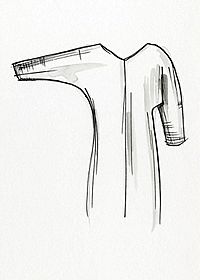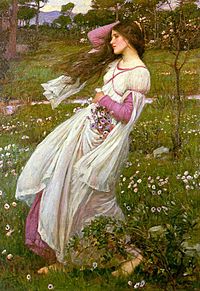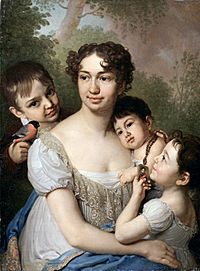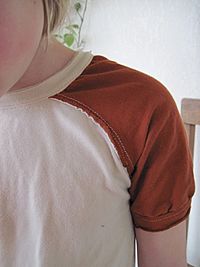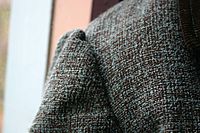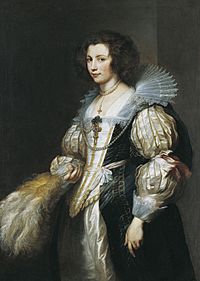Sleeve facts for kids
A sleeve is the part of a garment that covers your arm. It's where your arm goes through or "slips" into. The way sleeves are designed changes a lot with fashion trends, different countries, and time periods.
Long, hanging sleeves were once used like pockets, especially in places like China and Japan. This is where the saying "to have something up one's sleeve" comes from, meaning you have a secret plan ready. There are other fun sayings too, like "to wear one's heart upon one's sleeve" (meaning to show your feelings openly) or "to laugh in one's sleeve" (meaning to laugh secretly).
Sleeves can be very short, just covering the shoulder (called a cap sleeve), or they can be very long, even touching the floor! Most shirt sleeves today end somewhere between your upper arm and your wrist.
In the early Middle Ages, sleeves were cut straight. People added triangle-shaped pieces of fabric under the arm, called gussets, to help you move easily. Later, in the 1300s, people invented the rounded sleeve top. This allowed for sleeves that fit more closely to the arm.
Cool Types of Sleeves
The names for sleeves in old costumes are often modern names. Here are some interesting types of sleeves:
| Type | What it looks like | Picture |
|---|---|---|
| Angel sleeve | A long, wide sleeve that hangs loosely from the shoulder. | |
| Batwing sleeve | A long sleeve that has a very deep armhole, like a bat's wing. It gets narrower towards the wrist. It's also called a "magyar" sleeve. | |
| Bell sleeve | A long sleeve that fits closely from the shoulder to the elbow. Then, it gently flares out like a bell from the elbow down. | |
| Bishop sleeve | A long sleeve that is wider at the bottom than at the top. It gathers into a cuff at the wrist. | |
| Butterfly sleeve | Often seen on traditional Filipino clothes. These sleeves start at the shoulder and get wider towards the end, but they are usually short (about 4-5 inches long). Unlike bell sleeves, they don't go all the way around your arm. | |
| Cap sleeve | A very short sleeve that only covers the shoulder. It doesn't go below your armpit. Women often wear these. | |
| Cold shoulder sleeve | A long sleeve that has a cutout or opening on top of the shoulder, showing the upper part of your arm. | |
| Dolman sleeve | A long sleeve that is very wide at the top but becomes narrow at the wrist. | |
| Fitted point sleeve | A long, narrow sleeve that ends in a point, resting against the back of your hand. | |
| Gigot or leg o'mutton sleeve | A sleeve that is super wide over the upper arm. Then, it becomes very narrow from the elbow down to the wrist. | |
| Hanging sleeve | A sleeve that has an opening down the side, front, or at the elbow. This allows your arm to pass through the opening instead of the main sleeve. These were popular in the 1300s to 1600s. | |
| Juliet sleeve | A long, tight sleeve with a puffy part at the top. This style was inspired by old Italian fashion and named after Shakespeare's famous character, Juliet. It was popular in the early 1800s and again in the late 1960s. | |
| Kimono sleeve | A sleeve that is cut as one piece with the main body of the shirt or dress. It has a wide, sloping shape, like traditional Chinese robes. (Note: This is different from actual Japanese kimono sleeves, which are sewn separately). | |
| Pagoda sleeve | A wide, bell-shaped sleeve that was popular in the 1860s. People often wore a fake undersleeve, called an engageante, beneath it. | |
| Paned sleeve | A sleeve made from strips or "panels" of fabric. This design allows a lining or a shirt sleeve underneath to show through. This was popular in the 1500s and 1600s. | |
| Poet sleeve | A long sleeve that fits from the shoulder to the elbow. Then, it flares out quite a lot from the elbow to the wrist or even mid-hand. It often has ruffles at the cuffs. | |
| Puffed or puff sleeve | A short, three-quarter length, or full sleeve that is gathered at both the top and bottom. You often see these on wedding dresses and children's clothes today. | |
| Raglan sleeve | A sleeve that extends all the way up to the neckline of the garment. This design allows for easier movement. | |
| Set-in sleeve | A sleeve that is sewn into a special armhole, called an armscye. It's also known as a "Drop Sleeve." | |
| Two-piece sleeve | A sleeve cut from two pieces of fabric, an inner and an outer part. This helps the sleeve bend slightly like an "L" shape to fit the natural bend of your elbow without wrinkling. It's used in tailored clothes. | |
| Virago sleeve | A full "paned" sleeve that is gathered into two puffy sections. This is done with a ribbon or fabric band above the elbow. It was worn in the 1620s and 1630s. | |
| Wizard's sleeve | A sleeve that goes from the shoulder to the wrist, expanding into a cone shape. It drapes openly off the wrist. | |
| 1/4-length sleeve or quarter-length sleeve | A sleeve that goes from the shoulder to about midway down your biceps and triceps (the upper arm). | |
| ¾ length sleeve or three-quarter length sleeve | A sleeve that goes from the shoulder to about halfway between your elbow and your wrist. This was common in the United States in the 1950s and is popular again in the 21st century. |
See also
 In Spanish: Manga (indumentaria) para niños
In Spanish: Manga (indumentaria) para niños



